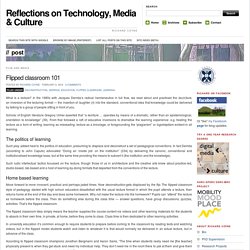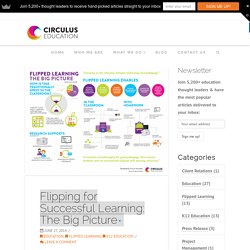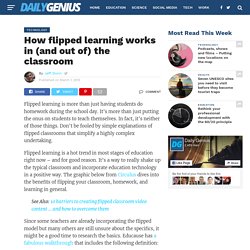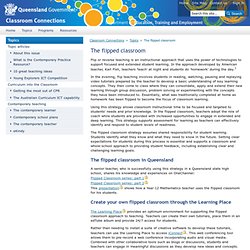

8 principles to help you advance to Flipped Learning 3.0. Flipped learning is evolving because of research, classroom innovation and new technologies.

Whereas educators asked about teacher and student satisfaction and achievement in flipped learning 1.0, flipped learning 3.0 focuses its questions on the effect of drawing or questions in flipped videos, the optimal time between individual work and group work, and the impact gamification has on a flipped classroom. School leaders hoping to bring flipped learning to scale in their classrooms should keep in mind eight very important principles as they begin their journey. 1. Teacher buy-in: “This is absolutely critical; it’s the mindset change–you have to convince your teachers to change their minds about what a classroom looks like,” Bergmann said.
Key questions often include what is the best use of face-to-face class time, and as Bergmann mention, it is not direct instruction. 2. 3. 4. 5. 6. 7. 8. Blended Learning vs Flipped Learning: Can You Tell The Difference? - eLearning Industry. Reflections on Technology, Media & Culture. What is a lecture?

In the 1980s with Jacques Derrida’s radical hermeneutics in full flow, we read about and practiced the lec(ri)ture, an inversion of the lecturing format — the insertion of laughter (ri) into the standard, conventional idea that knowledge could be delivered by talking to a group of people sitting in front of you. Scholar of English literature Gregory Ulmer asserted that “a lecriture … operates by means of a dramatic, rather than an epistemological, orientation to knowledge” (39). From that followed a raft of educative inversions to dramatise the learning experience: e.g. treating the lecture as a form of writing, learning as misreading, lecture as a bricolage, or foregrounding the “plagiarism” or logokleptism evident in all learning. The politics of learning Such play added heat to the politics of education, presuming to displace and deconstruct a set of pedagogical conventions.
Traditional instruction reformed with flipped classroom techniques. Flipped Learning: The Big Picture. Flipped Learning – Turning Learning Inside Out As we progress rapidly into the middle of the second decade of the 21st century, questions continue to be raised about how education addresses the ever increasing demands for change, integrating emerging technologies, and maximising the possibilities for every student.

Teachers are searching for ways to focus on engaging students in authentic, complex and powerful problem solving experiences for learning, unpacking content and demonstrating understanding and knowledge. The day is a finite resource, and class times are small segments of that day, so there are limitations on how much more can be accomplished in that specified time. 7 things you should know about flipped classrooms. How flipped learning works in (and out of) the classroom.
Flipped learning is more than just having students do homework during the school day.

It’s more than just putting the onus on students to teach themselves. In fact, it’s neither of those things. Don’t be fooled by simple explanations of flipped classrooms that simplify a highly complex undertaking. Comparing Blended and Flipped Learning [INFOGRAPHIC] This infographic, from the Innovative Learning Institute, offers an excellent analysis of the value blended learning can bring to a classroom, as well as why every flipped classroom is a blended learning environment, but every blended learning environment isn’t necessarily a flipped classroom.
![Comparing Blended and Flipped Learning [INFOGRAPHIC]](http://cdn.pearltrees.com/s/pic/th/infographic-actualization-107366796)
Be sure to click the infographic for the full version. Like this: Like Loading... A Great Chart Explaining The Flipped Classroom Concept. Informática Educativa — A Model for the Flipped Classroom. Flipped Classroom: The Full Picture. Blended-classrooms - The Flipped Classroom. The flipped classroom is an exciting new instructional approach.

As it is relatively new, much of the information about it only is available in the popular press. Little research can be found. On this page, I am pulling together what I can find relevant to flipped classrooms. Enjoy! What does this look like in K-12 classrooms? What is a flipped classroom? (in 60 seconds) Last week, I plopped down for Sunday brunch in New York City with some non-edu obsessed friends and acquaintances I had not seen in a long time.

About 10 seconds after our formal greetings, the person sitting across from me leaned forward and said, “So…not to be too business like, but what is a flipped classroom?” Surprised, I tilted my head and narrowed my eyes quizzically, the person sitting two seats over followed up with a smile and explanation: “We follow you on LinkedIn.” Not wanting to bore my friends with a long dissertation on the flipped class, I tried to explain the basics in an elevator speech. While I am not sure I succeed at brunch, the experience inspired me to challenge myself to define the flipped classroom in 60 seconds or less.The result of that challenge is the below video (with 14 seconds of intro and conclusion).
<a href=" Our Poll</a> Like this: Like Loading... Flipped Classroom - a definition from the Flipped Learning Network. How To Flip An Online Course. How To Give Your Online Class An In-Class Feel. Flipped Classroom. Flipped Classrooms: What are they all about? Home » News » Flipped Classrooms: What are they all about?

Flipped Classrooms: What are they all about? Tags: Flipped Classrooms, Khan Academy June 1, 2013 | No comment Although flipped classrooms are not a new idea there has recently been a lot of interest in this method. Chemicalsams: There Is No Such Thing as THE Flipped Class. The term "Flipped Classroom" is being thrown around a lot lately in both positive and negative light.

I think the term is a bit ambiguous and does not fully do justice to all that is being done under the guise of the Flipped Classroom. My colleague, Jon Bergmann, and I have a book coming out soon that I hope brings clarity to what most of us mean by "The Flipped Classroom. " In the mean time, I hope to shed some light on some of the confusion, critique, and hype. 1. The Flipped Classroom FAQ. The flipped classroom. Flip or reverse teaching is an instructional approach that uses the power of technologies to support focused and extended student learning.

In the approach developed by American teacher, Karl Fish, teachers 'teach' at night and students do 'homework' during the day.1 In the evening, flip teaching involves students in reading, watching, pausing and replaying video tutorials prepared by the teacher to develop a basic understanding of key learning concepts. They then come to class where they can consolidate, apply and extend their new learning through group discussion, problem solving or experimenting with the concepts they have been introduced to. Essentially, what was traditionally completed at home as homework has been flipped to become the focus of classroom learning. Using this strategy allows classroom instructional time to be focused and targeted to students' needs and prior knowledge.
Top Ed-Tech Trends of 2012: The Flipped Classroom. Part 4 of my Top Ed-Tech Trends of 2012 series “Flipping the classroom” is hardly new. But with all the hype surrounding both Khan Academy and MOOCs, it’s hardly surprising that the practice became incredibly popular this year. Indeed, in his 2011 TED Talk (which has been watched over 2 million times on YouTube), Salman Khan talked about the ways in which his videos are used by teachers to “flip the classroom.” That is, in lieu of teachers lecturing in the classroom, the Khan Academy video lectures are assigned as homework; then students work on exercises in class where the teacher can more easily assist and remediate.
“Flipping the classroom” has become a crucial part of the story that Khan repeats in his frequent talks and media appearances. It’s also become part of the argument that Coursera co-founder Daphne Koller makes about how massive open online classes or MOOCs (which, duh, is another huge ed-tech trend of 2012) will change the offline university experience. Flipped Classroom. How flipping works for you Save time; stop repeating yourself Record re-usable video lessons, so you don't have to do it again next year.
It's easy to make minor updates to perfect lessons over time once the initial recording is done. Let students take control of their learning. How the Flipped Classroom Is Radically Transforming Learning. Editor's Note:Posts about the flipped class on The Daily Riff beginning in January 2011 have generated over 240,000 views to-date - thanks contributors and readers . . . See our other links related to the flipped class below this guest post. Since this post was written, Bergmann and Sams have released their book, Flip your Classroom: Reach Every Student in Every Class Every Day. Do check it out. - C.J. Flipping the Classroom. 4/27/2012 By: Teachers from around the world have adopted the flipped classroom model and are using it to teach a variety of courses to students of all ages. In the excerpt below from the book, Flip Your Classroom (©2012, ISTE® International Society for Technology in Education and ASCD), authors Jonathan Bergmann and Aaron Sams outline reasons why educators should consider this model.
Flipping speaks the language of today’s students. Today’s students grew up with Internet access, YouTube, Facebook, MySpace, and a host of other digital resources. Instruction via video is not a big deal for [them]. Flipping helps busy students. The Flipped Classroom. What Is The Flipped Classroom Model And Why Is It Amazing? (With Infographic) The flipped classroom. Centre for Digital Education. Flip teaching. Flip teaching or a flipped classroom is a form of blended learning in which students learn new content online by watching video lectures, usually at home, and what used to be homework (assigned problems) is now done in class with teachers offering more personalized guidance and interaction with students, instead of lecturing. This is also known as backwards classroom, flipped classroom, reverse teaching, and the Thayer Method. "[1][2][3] Traditional vs flipped teaching[edit] The traditional pattern of teaching has been to assign students to read textbooks and work on problem sets outside school, while listening to lectures and taking tests in class.
"My AP Calculus class was a really anxious environment, it was weird trying to get through way too much material with not enough time. In flip teaching, the students first study the topic by themselves, typically using video lessons prepared by the teacher[5][6] or third parties. Flipped classrooms free class time for hands-on work. Math[edit] Flippedclassroom - Hamilton Middle School 8th Grade Science. The Flipped Classroom Explained In 22 Minutes - By Aaron Sams - Screencast.com Why a “flipped classroom?” Mr. Fuzak and I have taught for 10-years and we are always looking for a way to create a learning environment that allows for us to work with, interact with, and engage in learning with each student EVERY SINGLE DAY! Over the years it has become more difficult to interact and engage with each student, every day, no matter how hard we tried.